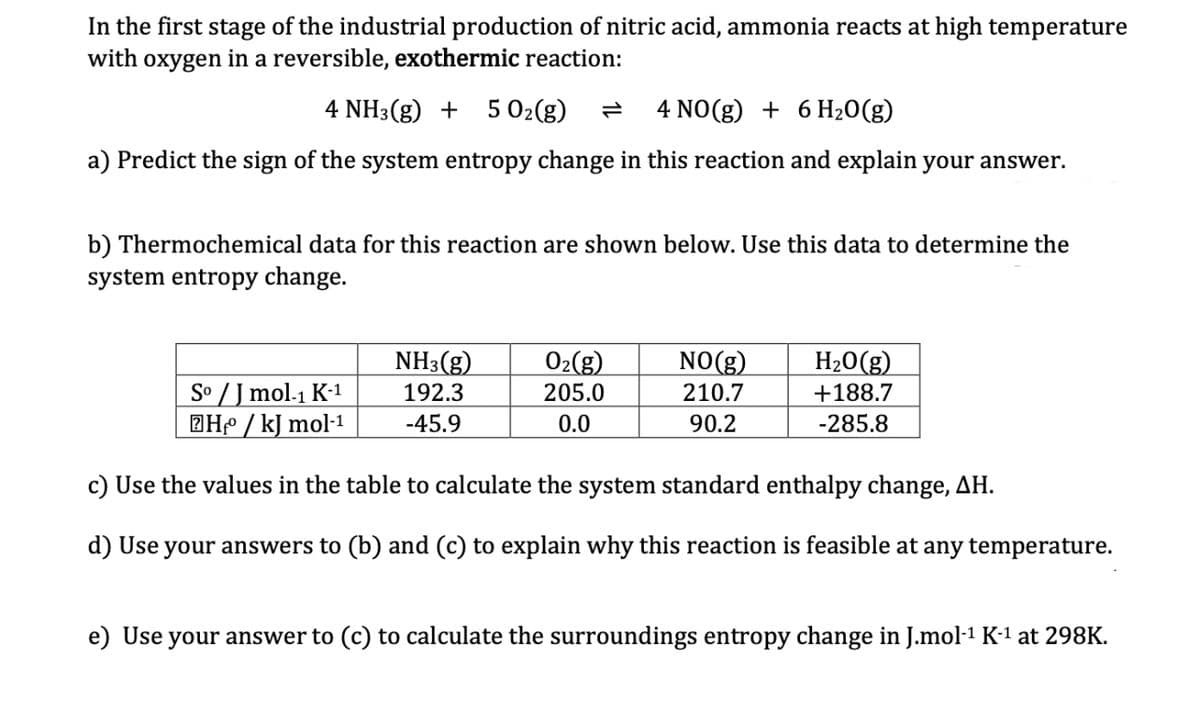In the first stage of the industrial production of nitric acid, ammonia reacts at high temperature with oxygen in a reversible, exothermic reaction: 4 NH3(g) + 5 0₂(g) 4 NO(g) + 6H₂O(g) a) Predict the sign of the system entropy change in this reaction and explain your answer.
In the first stage of the industrial production of nitric acid, ammonia reacts at high temperature with oxygen in a reversible, exothermic reaction: 4 NH3(g) + 5 0₂(g) 4 NO(g) + 6H₂O(g) a) Predict the sign of the system entropy change in this reaction and explain your answer.
Principles of Modern Chemistry
8th Edition
ISBN:9781305079113
Author:David W. Oxtoby, H. Pat Gillis, Laurie J. Butler
Publisher:David W. Oxtoby, H. Pat Gillis, Laurie J. Butler
Chapter13: Spontaneous Processes And Thermodynamic Equilibrium
Section: Chapter Questions
Problem 20P
Related questions
Question
A please

Transcribed Image Text:In the first stage of the industrial production of nitric acid, ammonia reacts at high temperature
with oxygen in a reversible, exothermic reaction:
4 NH3(g) + 5 0₂(g)
4 NO(g) + 6 H₂O(g)
a) Predict the sign of the system entropy change in this reaction and explain your answer.
b) Thermochemical data for this reaction are shown below. Use this data to determine the
system entropy change.
NH3(g)
192.3
-45.9
O₂(g)
205.0
0.0
NO(g)
210.7
90.2
H₂O(g)
+188.7
-285.8
Sº / J mol-1 K-1
H₂/kJ mol-¹
c) Use the values in the table to calculate the system standard enthalpy change, AH.
d) Use your answers to (b) and (c) to explain why this reaction is feasible at any temperature.
e) Use your answer to (c) to calculate the surroundings entropy change in J.mol-¹ K-¹ at 298K.
Expert Solution
This question has been solved!
Explore an expertly crafted, step-by-step solution for a thorough understanding of key concepts.
Step by step
Solved in 2 steps

Knowledge Booster
Learn more about
Need a deep-dive on the concept behind this application? Look no further. Learn more about this topic, chemistry and related others by exploring similar questions and additional content below.Recommended textbooks for you

Principles of Modern Chemistry
Chemistry
ISBN:
9781305079113
Author:
David W. Oxtoby, H. Pat Gillis, Laurie J. Butler
Publisher:
Cengage Learning

Chemistry: The Molecular Science
Chemistry
ISBN:
9781285199047
Author:
John W. Moore, Conrad L. Stanitski
Publisher:
Cengage Learning

Chemistry: Principles and Practice
Chemistry
ISBN:
9780534420123
Author:
Daniel L. Reger, Scott R. Goode, David W. Ball, Edward Mercer
Publisher:
Cengage Learning

Principles of Modern Chemistry
Chemistry
ISBN:
9781305079113
Author:
David W. Oxtoby, H. Pat Gillis, Laurie J. Butler
Publisher:
Cengage Learning

Chemistry: The Molecular Science
Chemistry
ISBN:
9781285199047
Author:
John W. Moore, Conrad L. Stanitski
Publisher:
Cengage Learning

Chemistry: Principles and Practice
Chemistry
ISBN:
9780534420123
Author:
Daniel L. Reger, Scott R. Goode, David W. Ball, Edward Mercer
Publisher:
Cengage Learning

General Chemistry - Standalone book (MindTap Cour…
Chemistry
ISBN:
9781305580343
Author:
Steven D. Gammon, Ebbing, Darrell Ebbing, Steven D., Darrell; Gammon, Darrell Ebbing; Steven D. Gammon, Darrell D.; Gammon, Ebbing; Steven D. Gammon; Darrell
Publisher:
Cengage Learning

Chemistry & Chemical Reactivity
Chemistry
ISBN:
9781337399074
Author:
John C. Kotz, Paul M. Treichel, John Townsend, David Treichel
Publisher:
Cengage Learning

Chemistry: An Atoms First Approach
Chemistry
ISBN:
9781305079243
Author:
Steven S. Zumdahl, Susan A. Zumdahl
Publisher:
Cengage Learning